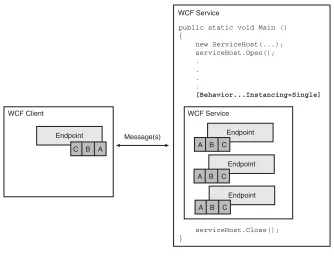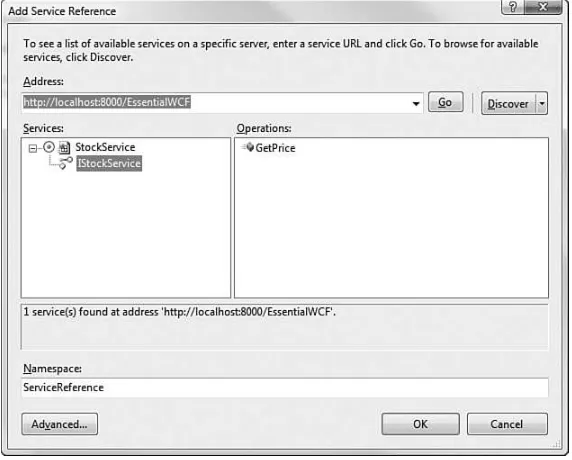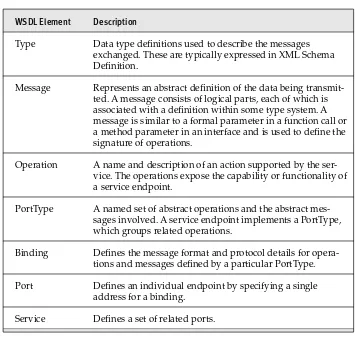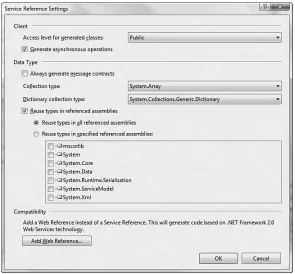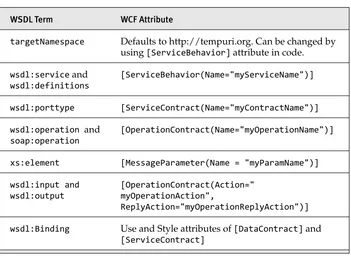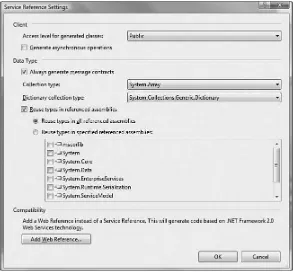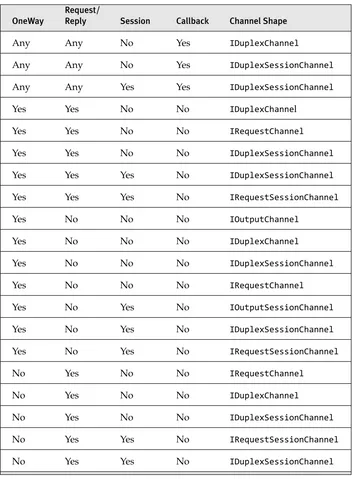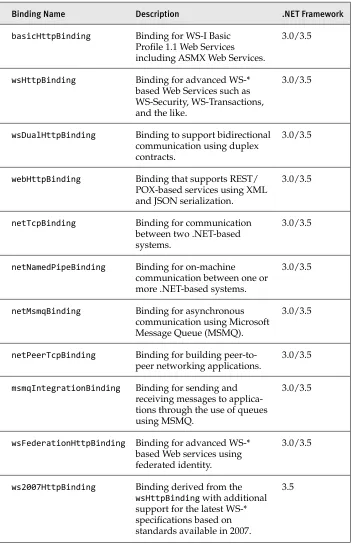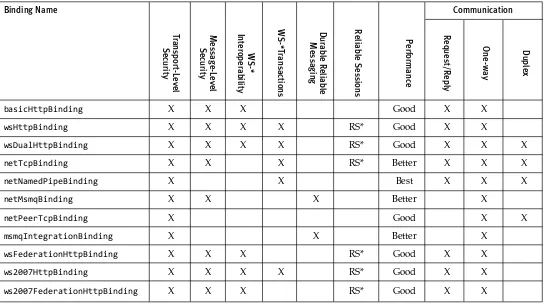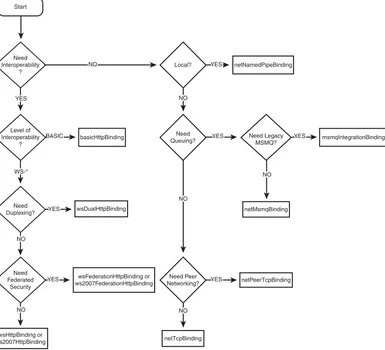Praise for
Essential Windows Communication Foundation
“Resnick, Crane, and Bowen have surveyed the essence of Microsoft’s Web services platform. Whether this is the first time or the fifty-first time you’re using WCF, you’ll learn something new by reading this book.”
—Nicholas Allen, Program Manager, Web Services, Microsoft
“As developers, we are constantly called upon to be ‘instant experts’ in many areas. When the time comes for you to begin working with distributed systems develop-ment and messaging in the new Microsoft .NET 3.x world, you find yourself con-fronted by the new 800-pound gorilla called Windows Communication Foundation (WCF). This is the book you want sitting on your desk when that day comes.”
—Ron Landers, Senior Technical Consultant, IT Professionals, Inc.
“Designing and writing distributed applications was one of the most complex and frustrating challenges facing .NET developers and architects. What technologies do you pick? There were so many choices and so little coding time. Windows Com-munication Foundation (WCF) solves this problem as the single unified platform to build distributed applications for .NET. Like any distributed system, WCF has a lot of choices and possibilities. This book provides an easy-to-digest approach that answers the spectrum of choices with real-world explanations and examples. Start-ing with the basics of WCF and buildStart-ing from there, this book answers the how you can use WCF today. It’s a must-read for application developers and architects build-ing any type of distributed application.”
—Thom Robbins, Director of .NET Platform Product Management, Microsoft
“Essential Windows Communication Foundation (WCF) is a truly comprehensive work that presents the technology in a clear, easy to read, yet comprehensive man-ner. The book will be an invaluable asset for both the advanced reader and new-comer to WCF.”
—Willy-Peter Schaub, Technology Specialist, Barone, Budge, and Dominick Ltd., Microsoft MVP
“It’s clear the authors drew on years of distributed applications development to dis-till and present the essence of WCF. The result is a book full of practical informa-tion designed to save you time and guide you on your WCF project. The chapter on diagnostics alone will save you hours of troubleshooting and frustration. Highly recommended.”
Essential
Windows
Communication
Microsoft .NET Development Series
John Montgomery, Series Advisor Don Box, Series Advisor
Brad Abrams, Series Advisor
The Microsoft .NET Development Series is supported and developed by the leaders and experts of Microsoft development technologies including Microsoft architects. The books in this series provide a core resource of information and understanding every developer needs in order to write effective applications and managed code. Learn from the leaders how to maximize your use of the .NET Framework and its programming languages.
Titles in the Series
Brad Abrams, .NET Framework Standard Library Annotated Reference Volume 1: Base Class Library and Extended Numerics Library, 0-321-15489-4 Brad Abrams and Tamara Abrams, .NET Framework Standard Library Annotated Reference, Volume 2: Networking Library, Reflection Library, and XML Library, 0-321-19445-4 Chris Anderson, Essential Windows Presentation Foundation (WPF), 0-321-37447-9
Keith Ballinger, .NET Web Services: Architecture and Implementation, 0-321-11359-4
Bob Beauchemin and Dan Sullivan, A Developer’s Guide to SQL Server 2005, 0-321-38218-8
Don Box with Chris Sells, Essential .NET, Volume 1: The Common Language Runtime, 0-201-73411-7 Keith Brown, The .NET Developer’s Guide to Windows Security, 0-321-22835-9
Eric Carter and Eric Lippert, Visual Studio Tools for Office: Using C# with Excel, Word, Outlook, and InfoPath, 0-321-33488-4
Eric Carter and Eric Lippert, Visual Studio Tools for Office: Using Visual Basic 2005 with Excel, Word, Outlook, and InfoPath, 0-321-41175-7
Mahesh Chand, Graphics Programming with GDI+, 0-321-16077-0
Steve Cook, Gareth Jones, Stuart Kent, Alan Cameron Wills, Domain-Specific Development with Visual Studio DSL Tools, 0-321-39820-3
Krzysztof Cwalina and Brad Abrams, Framework Design Guidelines: Conventions, Idioms, and Patterns for Reusable .NET Libraries, 0-321-24675-6
Len Fenster,Effective Use of Microsoft Enterprise Library: Building Blocks for Creating Enterprise Applications and Services, 0-321-33421-3
Sam Guckenheimer and Juan J. Perez, Software Engineering with Microsoft Visual Studio Team System,
0-321-27872-0
Anders Hejlsberg, Scott Wiltamuth, Peter Golde, The C# Programming Language, Second Edition, 0-321-33443-4 Alex Homer and Dave Sussman, ASP.NET 2.0 Illustrated, 0-321-41834-4
Joe Kaplan and Ryan Dunn, The .NET Developer’s Guide to Directory Services Programming, 0-321-35017-0
Mark Michaelis, Essential C# 2.0, 0-321-15077-5 James S. Miller and Susann Ragsdale, The Common Language Infrastructure Annotated Standard, 0-321-15493-2 Christian Nagel, Enterprise Services with the .NET Framework: Developing Distributed Business Solutions with .NET Enterprise Services, 0-321-24673-X Brian Noyes, Data Binding with Windows Forms 2.0: Programming Smart Client Data Applications with .NET, 0-321-26892-X
Brian Noyes, Smart Client Deployment with ClickOnce: Deploying Windows Forms Applications with ClickOnce, 0-321-19769-0
Fritz Onion with Keith Brown, Essential ASP.NET 2.0, 0-321-23770-6
Fritz Onion, Essential ASP.NET with Examples in C#, 0-201-76040-1
Fritz Onion, Essential ASP.NET with Examples in Visual Basic .NET, 0-201-76039-8
Scott Roberts and Hagen Green, Designing Forms for Microsoft Office InfoPath and Forms Services 2007, 0-321-41059-9
Dr. Neil Roodyn, eXtreme .NET: Introducing eXtreme Programming Techniques to .NET Developers, 0-321-30363-6 Chris Sells and Michael Weinhardt, Windows Forms 2.0 Programming, 0-321-26796-6
Dharma Shukla and Bob Schmidt, Essential Windows Workflow Foundation, 0-321-39983-8
Guy Smith-Ferrier, .NET Internationalization: The Developer’s Guide to Building Global Windows and Web Applications, 0-321-34138-4
Will Stott and James Newkirk, Visual Studio Team System: Better Software Development for Agile Teams, 0-321-41850-6 Paul Vick, The Visual Basic .NET Programming Language, 0-321-16951-4
Damien Watkins, Mark Hammond, Brad Abrams,
Programming in the .NET Environment, 0-201-77018-0 Shawn Wildermuth, Pragmatic ADO.NET: Data Access for the Internet World, 0-201-74568-2
Paul Yao and David Durant, .NET Compact Framework Programming with C#, 0-321-17403-8
Paul Yao and David Durant, .NET Compact Framework Programming with Visual Basic .NET, 0-321-17404-6
For .NET Framework 3.5
Steve Resnick
Richard Crane
Chris Bowen
Essential
Windows
Communication
Foundation
Many of the designations used by manufacturers and sellers to distinguish their products are claimed as trademarks. Where those designations appear in this book, and the publisher was aware of a trademark claim, the designations have been printed with initial capital letters or in all capitals.
The authors and publisher have taken care in the preparation of this book, but make no expressed or implied warranty of any kind and assume no respon-sibility for errors or omissions. No liability is assumed for incidental or consequential damages in connection with or arising out of the use of the information or pro-grams contained herein.
The publisher offers excellent discounts on this book when ordered in quantity for bulk purchases or special sales, which may include electronic versions and/or custom covers and content particular to your business, training goals, marketing focus, and branding inter-ests. For more information, please contact:
U.S. Corporate and Government Sales (800) 382-3419
For sales outside the United States please contact:
International Sales
Visit us on the Web: informit.com/aw
Library of Congress Cataloging-in-Publication Data:
Resnick, Steve.
Essential Windows Communication Foundation (WCF) / Steve Resnick, Richard Crane, Chris Bowen.
p. cm. Includes index.
ISBN 0-321-44006-4 (pbk. : alk. paper) 1. Applica-tion software—Development. 2. Microsoft Windows (Computer file) 3. Web services. 4. Microsoft .NET. I. Crane, Richard. II. Bowen, Chris. III. Title.
QA76.76.A65R46 2008 005.2’768—dc22
2007049118
Copyright © 2008 Pearson Education, Inc.
All rights reserved. Printed in the United States of America. This publication is protected by copyright, and permission must be obtained from the publisher prior to any prohibited reproduction, storage in a retrieval system, or transmission in any form or by any means, electronic, mechanical, photocopying, record-ing, or likewise. For information regarding permis-sions, write to:
Pearson Education, Inc
Rights and Contracts Department 501 Boylston Street, Suite 900 Boston, MA 02116
Fax (617) 671 3447
ISBN-13: 978-0-321-44006-8 ISBN-10: 0-321-44006-4
Text printed in the United States on recycled paper at Courier in Stoughton, Massachusetts.
First printing, February 2008
To my parents for pointing me in the right direction, to Zamaneh for making
the journey so sweet, and to Noah and Hannah for showing me the future.
—Steve
Dedicated to my loving wife, Nicki, my son, Matthew, and my daughter,
Charlotte. Thank you for your support and understanding. I love you all
very much and look forward to spending more time together.
—Rich
Thank you to my wife, Jessica, and my daughters, Deborah and Rachel, for
their love and understanding as I again devoted long nights and weekends
to research and writing. We have a book we can be proud of, but now I’m
Contents
Foreword xxv
Preface xxvii
Acknowledgments xxxiii
1
Basics
1
Why WCF Matters 1
Introduction 3
Implementing a WCF Service 6
Just the ABCs 7
Writing a WCF Service Entirely in Code 7
Writing a Service with Code and Configuration Files 10
More on Configuration Files 12
More on Service Hosting 13
Exposing the Metadata Exchange (MEX) Endpoint 14
Implementing a Client for a WCF Service 18
Writing a WCF Client Entirely in Code 18
Writing a Client with Code and Configuration 19
Hosting a Service in IIS 23
Discussion 23
Hosting a Service in IIS in Three Steps 24
Implementing a WCF Client for an ASMX Service 27
Tools Support 27
Generating Client Proxy Class and Configuration Files 28
2
Contracts
33
Service Contracts 37
Synchronous Request-Response Operations 38
Asynchronous Request-Response Operations 41
One-Way Operations 44
Duplex Operations 46
Multiple Contracts and Endpoints in a Service 54
Names of Operations, Types, Actions, and Namespaces in WSDL 57
Data Contracts 60
Defining XML Schema for a .NET Class 62
Defining Class Hierarchies 65
Exposing Additional Types in WSDL with KnownTypes 67
Versioning Data Contracts 72
Data Contract Equivalence 75
Working with Collections 76
Message Contracts 78
Typed Messages 79
Untyped Messages 82
Using SOAP Headers with Untyped Messages 85
3
Channels
91
Channel Shapes 94
One-Way Communication Pattern 94
Duplex Communication 95
Request-Reply Communication 97
Shape Changing 98
Operation Contract and Channel Shapes 99
Channel Listeners 101
Channel Factories 102
ChannelFactory<> 104
ICommunicationObject 105
4
Bindings
111
Choosing an Appropriate Binding 116
Sample Application 119
Contents
Cross-Machine Communication Between .NET Applications 123
netTcpBinding 123
Local Machine Communication Between .NET Applications 127
netNamedPipeBinding 128
Communication Using Basic Web Services 131
basicHttpBinding 132
Communication Using Advanced Web Services 135
wsHttpBinding 137
ws2007HttpBinding 140
wsDualHttpBinding 143
Comparing Binding Performance and Scalability 152
Communication Using Queued Services 154
netMsmqBinding 155
msmqIntegrationBinding 165
Creating a Custom Binding 168
User-Defined Bindings 171
Binding Elements 171
Transports 172
Encoders 173
Security 174
Transport Upgrades/Helpers 175
Shape Change 176
Other Protocols 177
Exposing a Service Contract over Multiple Bindings 177
5
Behaviors
181
Concurrency and Instancing (Service Behavior) 184
Default Concurrency and Instancing with Sessionless Binding 187
Multithreading a Single Instance 189
Implementing a Singleton 190
Session-Level Instances 193
Controlling the Number of Concurrent Instances 195
Controlling the Number of Concurrent Calls 199
Controlling the Number of Concurrent Sessions 201
Exporting and Publishing Metadata (Service Behavior) 204
Implementing Transactions (Operation Behavior) 207
Transactional Operations Within a Service 208
Flowing Transactions Across Operations 215
Choosing a Transaction Protocol—OleTx or WS-AT 221
Transaction Service Behaviors 223
Implementing Custom Behaviors 224
Implementing a Message Inspector for Service Endpoint Behavior 227 Exposing a Parameter Inspector for Service Operation Behavior
as an Attribute 230
Exposing a Service Behavior Through Configuration 233
Security Behaviors 237
6
Serialization and Encoding
241
Serialization Versus Encoding 241
Comparing WCF Serialization Options 243
DataContractSerializer 243
NetDataContractSerializer 247
XmlSerializer 249
DataContractJsonSerializer 252
Choosing a Serializer 254
Preserving References and Cyclical References 254
Sharing Type with the NetDataContractSerializer 260
Roundtrip Serialization Using IExtensibleDataObject 264
Serializing Types Using Surrogates 270
Streaming Large Data 276
Using the XmlSerializer for Custom Serialization 277
Custom XmlSerialization Using Attributes 278
Custom XmlSerialization Using IXmlSerializable 279
Choosing an Encoder 281
Text Versus Binary Encoding 282
Sending Binary Data Using MTOM Encoding 283
Getting to Know the WebMessageEncoder 284
7
Hosting
287
Hosting a Service in Windows Process Activation Services 288
Hosting a Service in IIS 7 292
Contents
Enabling ASMX Features in an IIS-Hosted Service 294
Self-Hosting 301
Self-Hosting in a Managed Windows Service 302
Hosting Multiple Services in One Process 305
Defining Service and Endpoint Addresses 308
8
Security
315
WCF Security Concepts 316
Authentication 316
Authorization 316
Confidentiality 317
Integrity 317
Transport and Message Security 317
Certificate-Based Encryption 319
Concepts 319
Setup 320
Transport-Level Security 322
Encryption Using SSL 323
Client Authentication 327
Service Identity 332
Message-Level Security 334
Authenticating with wsHttpBinding 335
Securing Services with Windows Integrated Security 340
Section Examples Introduction 341
Authenticating Users with Windows Credentials 343
Authorizing Users with Windows Credentials 346
Authorization Using AzMan 348
Impersonating Users 353
Securing Services over the Internet 358
ASP.NET Integration 360
Authentication Using Membership Providers 361
Role-Based Authorization Using Role Providers 364
Using Forms Authentication 366
Logging and Auditing 371
9
Diagnostics
375
Sample WCF Application 376
Tracing 376
End-to-End Tracing 377
Activities and Correlation 378
Enabling Tracing 379
Verbosity Recommendations 381
Message Logging 381
Enabling Message Logging 381
Additional Configuration Options 383
Shared Listeners 384
Message Filters 384
Trace Source Auto Flushing 385
Performance Counters 386
Windows Management Instrumentation (WMI) 387
Using the Service Configuration Editor 387
Tracing Options 389
Logging Options 389
Configuring Sources 390
Configuring Listeners 391
Service Trace Viewer 393
Activity View 393
Project View 395
Message View 395
Graph View 395
Analyzing Logs from Multiple Sources 397
Filtering Results 400
10
Exception Handling
403
Introduction to WCF Exception Handling 404
WCF Exception Communication via SOAP 404
Unhandled Exception Example 405
Detecting and Recovering a Faulted Channel 408
Communicating Exception Details 409
Managing Service Exceptions with FaultException 411
Using FaultCode and FaultReason to Extend FaultException 412
Contents
Limitations of Basic FaultExceptions 414
Creating and Consuming Strongly Typed Faults 415
Declaring Fault Definitions with FaultContract 415
Defining a FaultContract 417
Throwing a FaultException<> with a Defined FaultContract 418
Fault Contract Strategies 419
Implementing Client Fault Handlers 419
Error-Handling Application Block 420
Exception Shielding 421
11
Workflow Services
423
Integration Points 424
Calling a WCF Service from WF 426
Using a Send Activity 427
Writing a Custom Activity 430
Exposing a Service from WF 433
Define the Interface 434
Receive Activity 435
Configuration in app.config 439
Hosting a Service-Enabled Workflow 441
Self-Hosting a Service-Enabled Workflow 442
Hosting a Service-Enabled Workflow in IIS 443
Correlation and Durable Services 444
Long-Running Workflow 445
Handling the Context 450
Persisting Workflow State on the Server 452
Controlling Access to Service-Enabled Workflows 454
Declarative Access Control 455
Programmatic Access Control 455
12
Peer Networking
459
Approaches to Building Distributed Applications 459
Client/Server Applications 460
N-Tier Applications 460
Peer-to-Peer Applications 461
Comparison of Distributed Approaches 462
Peer-to-Peer Applications 462
Mesh Networks 462
Resolving Peer Meshes 464
Message Flooding Versus Directional Messaging 464
Creating Peer-to-Peer Applications 465
netPeerTcpBinding 465
Resolving Peers Using PNRP 468
PNRP Bootstrap Process 469
Windows Internet Computer Names 469
PnrpPeerResolver 470
Mesh Authentication 471
Registering Names Using PNRP 471
System.Net.Peer 472
Implementing a Custom Peer Resolver 474
Limiting the Number of Hops for a Message 478
Collaboration Using Windows Vista 480
People Near Me 481
Windows Contacts 482
Invitations 483
System.Net.PeerToPeer.Collaboration 485
Directional Messaging Using Custom Binding 492
13
Programmable Web
503
All About the URI 504
The Ubiquitous GET 506
Format Matters 507
Web Programming with WCF 507
URI and UriTemplates 508
Building URIs 509
Parsing URIs 510
Creating Operations for the Web 511
Hosting Using WebHttpBinding 512
Using WebGet and WebInvoke 514
WebGet 514
WebInvoke 514
Contents
Programming the Web with AJAX and JSON 516
ASP.NET AJAX Integration 516
Using the WebOperationContext 523
Hosting for the Web 530
WebScriptServiceHost 530
WebScriptServiceHostFactory 530
Content Syndication with RSS and ATOM 531
Appendix
Advanced Topics
537
Publishing Metadata Endpoints 537
mexHttpBinding 538
mexNamedPipeBinding 538
mexTcpBinding 538
mexHttpsBinding 539
Creating Clients from Metadata 539
Creating Silverlight Clients from Metadata 541
Sharing Ports Between Services 542
Configuring Service Quota Settings 543
Configuring HTTP Connections 545
Recycling Idle Connections 546
Adjusting Connection Lifetime 546
Disabling HTTP Keep-Alives 547
Increasing Number of Connections 549
Configuring TCP Connections 549
Recycling Idle Connections 549
Adjusting Connection Lifetime 550
Increasing Number of Connections 550
Using LINQ with WCF 550
Exposing LINQ-to-SQL Entities 550
Index 553
Figures
Figure 1.1: Communication between client and service 4
Figure 1.2: Communication between client and service endpoints 5 Figure 1.3: Hosting a service 6
Figure 1.4: Obtaining metadata through MEX endpoint 15
Figure 1.5: Visual Studio generating client proxy class and configuration file 21
Figure 2.1: High-level translation of code artifacts to WSDL 37 Figure 2.2: High-level translation of code syntax to WSDL 38 Figure 2.3: Synchronous request-response communication 38
Figure 2.4: Specifying asynchronous methods in Add Service Reference 42 Figure 2.5: Asynchronous request-response communication 43
Figure 2.6: Duplex communication 47
Figure 2.7: High-level translation of code artifacts to XSD 61 Figure 2.8: High-level translation of code syntax to XSD 62
Figure 2.9: Specifying message contracts in Add Service Reference 80
Figure 3.1: Channel stack 93
Figure 3.2: One-way communication 95 Figure 3.3: Duplex communication 96 Figure 3.4: Request-reply communication 97
Figure 3.5: ICommunicationObject state diagram 107
Figure 4.1: Binding Explorer 115 Figure 4.2: Selecting a binding 118 Figure 4.3: Average response time 153 Figure 4.4: Operations per second 153 Figure 4.5: Cost per operation 154
Figure 5.1: Behavior elements 183
Figure 5.2: Output from default InstanceContextMode and ConcurrencyMode with
sessionless binding 189
Figure 5.3: Output from InstanceContextMode.Single and ConcurrencyMode.
Multiple 191
Figure 5.4: Output from singleton: InstanceContextMode.Single and
ConcurrencyMode.Single 192
Figure 5.5: Output from session-aware service 196
Figure 5.6: Output controlling the number of concurrent instances 199 Figure 5.7: Output controlling the number of concurrent calls 202 Figure 5.8: Output controlling the number of concurrent sessions 204 Figure 5.9: ACID transaction within an operation 209
Figure 5.10: Output from transactional service showing local and distributed
transaction IDs 214
Figure 5.11: Output from optimized transactional service 215 Figure 5.12: Transaction that spans service boundaries 216
Figure 5.13: Output from two transactional services coordinated in a single
transaction 221
Figure 5.14: Interfaces for building custom behaviors on the client 225 Figure 5.15: Interfaces for building custom behaviors on the server 225
Figure 6.1: XML Information Set 242 Figure 6.2: XSD types 244
Figure 7.1: WAS architecture 289
Figure 7.2: Enabling Windows Process Activation Services 290 Figure 7.3: Enabling WCF non-HTTP activation 290
Figure 7.4: IIS implemented on WAS 293 Figure 7.5: Service control manager 305
Figure 7.6: Viewing address and binding from a running service 311
Figure s
Figure 8.1: Configuring IIS 7 for SSL 324
Figure 8.2: Services over corporate LAN with Windows application 341 Figure 8.3: Configuring an XML Authorization store 349
Figure 8.4: Creating a role definition with Authorization Manager 350 Figure 8.5: Authorization Manager showing example configuration 351 Figure 8.6: Services over Internet with Windows application 359 Figure 8.7: Sample Internet application 359
Figure 8.8: Services over Internet with Web application 367
Figure 9.1: Tracing and MessageLogging enabled 388 Figure 9.2: Advanced Message Logging settings 389 Figure 9.3: Message Logging XPath Filter 390 Figure 9.4: Trace Source settings 391
Figure 9.5: Listener settings 392
Figure 9.6: Detailed listener configuration 392
Figure 9.7: Service Trace Viewer with client trace and message logs 394 Figure 9.8: Service Trace Viewer Message view 396
Figure 9.9: Service Trace Viewer Graph view 396
Figure 9.10: Service Trace Viewer with service and client logs loaded 398 Figure 9.11: Service Trace Viewer graph of activity transfer 399
Figure 9.12: Service Trace Viewer with expanded subtract call activity 400 Figure 9.13: Creating a custom filter in the Service Trace Viewer 401
Figure 10.1: FaultException returned by calling service with zero denominator 407 Figure 10.2: CommunicationObjectFaultedException for faulted channel 407 Figure 10.3: Exception detail included with ServiceDebugBehavior 410
Figure 11.1: WF behaviors 426
Figure 11.2: Adding a Send activity to a workflow design surface 428 Figure 11.3: Proxy type was imported so an operation can be chosen 429 Figure 11.4: Binding WF variable to service operation parameters 430 Figure 11.5: Using a custom activity in a workflow 433
Figure 11.6: Adding a Receive activity to the workflow design surface 436 Figure 11.7: Entering or importing an interface for a Receive activity 437 Figure 11.8: Binding operation contract parameters to workflow variables 438
Figure 11.9: Workflow exposing one Receive activity 439
Figure 11.10: Composite Receive activity in a long-running workflow 446 Figure 11.11: Completing a long-running workflow 448
Figure 11.12: One client maintaining context with multiple calls to a
workflow instance 451
Figure 11.13: Multiple clients maintaining context with multiple calls to a
workflow instance 452
Figure 11.14: Declarative authorization within a Receive activity 456
Figure 12.1: Client/server model 460 Figure 12.2: Three-tier model 461
Figure 12.3: Peer model with three nodes 461 Figure 12.4: Fully connected mesh 463 Figure 12.5: Partially connected mesh 464
Figure 12.6: Windows Internet Computer Name (WICN) 470 Figure 12.7: Number of hops across connected nodes 479 Figure 12.8: People Near Me Control Panel 481
Figure 12.9: Allow invitations 482 Figure 12.10: Windows Contacts 482
Figure 12.11: Windows Contact Properties 483 Figure 12.12: Windows Meeting Space invitation 484 Figure 12.13: Windows Meeting Space invitation details 484 Figure 12.14: Peer Chat sample application 485
Figure 12.15: Enabling Teredo using NetSh 500
Figure 13.1: Response in browser using WebHttpBinding binding 514 Figure 13.2: XBOX 360 Game Review AJAX-enabled application 517 Figure 13.3: Wallpaper Web application 524
Figure A.1: Starting Net.Tcp Port Sharing Service from command line 543 Figure A.2: IIS 7.0 settings for HTTP Keep-Alives 548
Figure A.3: LINQ-to-SQL Object Relational Designer 551
Figure s
Tables
Table 1.1: Options for Generating Proxy Class and Configuration File 28
Table 2.1: WSDL Elements 35
Table 2.2: Paired One-Way Versus Duplex Contracts for Bidirectional
Communication 48
Table 2.3: WCF Attributes That Override Default WSDL Names 58
Table 3.1: Channel Shapes Based on OperationContract Attributes 100
Table 4.1: WCF Communication Bindings in .NET Framework 3.5 112 Table 4.2: Supported Features of Each Binding 117
Table 4.3: netTcpBinding Binding Properties 124 Table 4.4: netNamedPipeBinding Binding Properties 129 Table 4.5: basicHttpBinding Binding Properties 133
Table 4.6: WS-* Specifications Supported by the wsHttpBinding Binding 136 Table 4.7: wsHttpBinding Binding Properties 137
Table 4.8: WS-* Specifications Supported by the ws2007HttpBinding
Binding 140
Table 4.9: ws2007HttpBinding Binding Properties 141 Table 4.10: wsDualHttpBinding Binding Properties 144 Table 4.11: netMsmqBinding Binding Properties 156 Table 4.12: msmqIntegrationBinding Binding Properties 166
Table 5.1: Combining InstanceContextMode and ConcurrencyMode 186 Table 5.2: Interaction of TransactionFlow elements 217
Table 7.1: Settings for Enabling ASMX Features in a WCF Service 296 Table 7.2: Hosting Choices 312
Table 8.1: Client Authentication with Transport Security 328
Table 9.1: Tracing Source switchValue Options 380 Table 9.2: messageLogging Options 383
Table 12.1: netPeerTcpBinding Binding Properties 466
Table 13.1: URI Examples 505 Table 13.2: Common HTTP Verbs 506
Table 13.3: Web Programming Features in .NET Framework 3.5 508
Table A.1: ServiceThrottlingBehavior Properties 544
Table s
Foreword
I ’M W R I T I N G T H I Sforeword in December of 2007, a little more than a year after the first release of Windows Communication Foundation hit the streets as part of .NET Framework 3.0 and less than a month after we shipped significant additions to the platform as part of .NET Framework 3.5. Saying there’s a lot to absorb in those two releases is something of an understatement.
One of the goals of WCF was to unify the programming experience for building all types of distributed applications on the Microsoft platform. We wanted a core set of concepts that were simple and approachable, yet expressive enough to model the underlying semantics of all the technologies we intended to replace. The Microsoft stacks that came before us (ASMX, Remoting, COM+, MSMQ, and WSE) had strong benefits as well as signifi-cant limitations; our mission was to leverage ideas that had worked well in the past and learn from those that didn’t. If we succeeded, developers would be able to write many different types of distributed applications without having to learn many different (and often wildly discontinuous) program-ming models.
To make the vision of a unified developer experience successful in the real world, we needed a highly flexible runtime architecture that matched the richness of the programming model. Key areas of variability had to be identified and isolated into generalized extensibility mechanisms to avoid unnecessarily restricting the capabilities of our new platform. Our goal with the runtime was to make sure that, if our default behavior didn’t meet the needs of a particular application or we lacked a feature required by a
specific scenario, there would be a natural point in the runtime into which an external developer could plug some customization to address the issue.
The most exciting part about WCF for me is the amazing breadth of sce-narios to which this technology can be applied. Nothing demonstrates that more concretely than the feature set we delivered in .NET 3.5. This release had two parallel thrusts covering very different types of distributed appli-cation scenarios. One thrust was about integrating WCF with the power of Windows Workflow Foundation to provide a substrate for long-running, declarative, connected business processes. The other thrust was about extending the reach of WCF to address the needs of today’s evolving Web. Both of these scenarios impose unique requirements on the runtime and programming model, and the fact that we were able to address these requirements via extensions to WCF without requiring significant changes to the existing implementationis a strong indicator that the WCF architecture will be able to address the evolving needs of distributed applications for a long time to come.
Now that we’re a year out from shipping our first bits, it’s exciting to see real customers make big bets on our platform. It’s more exciting to hear about the gains they see in the areas of developer productivity, perform-ance, and interoperability as a result of betting on WCF. We judge the suc-cess of our platform first and foremost by the sucsuc-cess of our customers, and by that metric WCF will be a very successful platform indeed.
Really, this is all just a long-winded way of saying that the time you invest in learning WCF is well spent. To that end, you’re very lucky to be holding this book in your hands right now. Rich, Chris, and Steve have done a fantastic job distilling the broad story of WCF down to the essential elements required to be productive on our platform. The authors’ unique combination of technical acumen, field experience, and close relationship with the product team has yielded a book that will undoubtedly hold a dis-tinguished place on every WCF developer’s bookshelf. I’m incredibly happy to have these guys telling the technical story of our product. By the end of this book, I’m sure you’ll feel the same way.
Steve Maine
Seattle, Washington December 2007
Foreword
Preface
WI N D O W S CO M M U N I C AT I O N FO U N D AT I O N (WCF) is the unified pro-gramming model for writing distributed applications on the Microsoft plat-form. It subsumes the prior technologies of ASMX, .NET Remoting, DCOM, and MSMQ and provides an extensible API to meet a wide variety of distributed computing requirements. Prior to WCF, you needed to mas-ter each of those technologies to select the right approach for a particular distributed application requirement. WCF simplifies this considerably by providing a unified approach.
XML Web Services is the most common technique for distributed com-puting in modern applications. They’re used to expose technical and busi-ness functions on private or public networks. Sometimes they use the SOAP specification, sometimes they don’t. They typically transmit infor-mation as text documents containing angle brackets, but not always. They generally use HTTP for the transport, but again, not always. WCF is a framework for working with XML Web Services and is compatible with most technology stacks.
Rich, Chris, and I have each developed code with .NET from the begin-ning (circa 1999). We work at Microsoft in the field, helping customers use WCF to solve real-world problems. Our customers range from large multi-national corporations to ISVs to Web startups. Each has different chal-lenges, needs, and priorities that we individually address. We show them what’s possible, recommend what works well, and steer clear of what doesn’t. We have experience building distributed applications and leverage that experience in teaching others about WCF.
Our goal for this book is to present WCF in a way that can immediately be put to use by software developers. We cover the material in enough detail that you know how and why to use different features. We go a bit fur-ther in most cases, describing some of the subtleties in the framework, but not so far as to document the API.
The Blogosphere is rich with WCF details. Much of it comes from the .NET product team and much of it comes from other developers learning it along the way. We made extensive use of blogs as source material. This book brings order to that repository by organizing it in a way that can be easily consumed from your desk, sofa, or wherever you do your best reading.
Who Should Read This Book?
We wrote this book for software developers who want to build distributed applications on the .NET platform. As fellow developers, we know the importance of solid advice and clear examples on how to use new technol-ogy. We’ve trolled the Blogosphere, scoured internal Microsoft e-mail aliases, and wrote plenty of code to provide you with the best examples for doing the things you need to do.
Architects who need to understand WCF will also benefit from this book. The chapters covering basics,bindings,channels,behaviors,hosting,
workflow, and security describe important aspects of designing and imple-menting services with WCF. Reading the two- to three-page introductions in each of these chapters may be the best way to get the 50,000-foot view of the technology.
Our goal in writing this book is to shorten your learning curve for WCF. We describe and demonstrate how to do the common tasks, addressing the basics as well as advanced topics. Throughout the book, we approach top-ics as a series of problems to be solved. Rather than documenting the API, we describe how to use WCF to accomplish your goals.
Prerequisites for this book are modest. If you’re interested in WCF, you probably already have grounding in .NET. You’re probably competent in C# or Visual Basic, or at least you were at one point. And, of course, you probably know your way around Visual Studio. So we’re assuming that
Preface
you can write decent .NET code and are motivated to make the best use of your time in becoming proficient in WCF.
Installation Requirements
WCF is a key component of the Microsoft .NET Framework 3.x. WCF was first released with .NET 3.0 and has been enhanced in .NET 3.5. The delta between the two releases is modest: enhancements for non-SOAP Web services, integration between WCF and WF, and a healthy service pack. This book covers .NET 3.5. Unless there’s a reason to use an older release, this is the clear recommendation.
.NET is packaged in two forms: the redistributable runtime libraries and the software development kit (SDK). The runtime libraries are meant for target machines—those machines that are not for development. This includes testing, staging, and production environments. The SDK is meant for your development machines. The SDK contains code samples, docu-mentation, and tools that are useful for development. Each of these .NET packages, the runtime and SDK versions, can be downloaded from Microsoft’s MSDN site at http://msdn2.microsoft.com/en-us/netframe-work/default.aspx. The .NET 3.5 SDK also ships with Visual Studio 2008. The Microsoft .NET Framework 3.5 can be installed on Windows XP SP2, Windows Vista, Windows Server 2003, and Windows Server 2008.
Organization
We don’t expect you to read the book cover to cover. If you’re new to WCF, you may want to read and try the samples in Chapter 1, “Basics,” first. Fol-lowing that, each subsequent chapter covers a major feature set of WCF. We include a few introductory pages in each chapter to describe the motivation and some design goals, and then we cover subtopics within the chapter. Chapter 1, “Basics,” is where we cover the basics of building and con-suming WCF services. We discuss and demonstrate how to implement dif-ferent types of interfaces and why you may choose each. By the end of this chapter, you’ll be able to produce and consume services using WCF.
Chapter 2, “Contracts,” covers the three primary types of contacts in WCF: service contracts, data contracts, and message contracts. Each of these enables you to define complex structures and interfaces in code. Data con-tracts map .NET types to XML, service concon-tracts expose service interface endpoints in WSDL that can be consumed in a cross-platform manner, and message contracts enable developers to work directly on the XML in a mes-sage, rather than working with .NET types. For each of these contracts, WCF tools generate and export standards-based WSDL to the outside world.
Chapter 3, “Channels,” covers channels and channel stacks. The channel model architecture is the foundation on which the WCF communication framework is built. The channel architecture allows for the sending and receiving of messages between clients and services. Channel stacks can be built to exactly match your needs.
Chapter 4, “Bindings,” describes how to configure the communication stack to use exactly the protocols you need. For instance, if you’re commu-nicating within an enterprise and won’t be crossing firewalls, and you need
the fastest performance, a binding named will give you best
results. If you’re looking to communicate with every last Web client out
there, then HTTP and text encoded XML is necessary, so
is the way to go. A binding is synonymous with a preconfigured channel stack.
Chapter 5, “Behaviors,” covers service behaviors. In WCF, behaviors are the mechanism for affecting service operation outside of the actual message processing. Everything that is done after a message is received but before it is sent to the service operation code is the domain of behaviors. In WCF, this is where concurrency and instance management is handled, as well as transactional support. This chapter also demonstrates how to build custom behaviors for additional service control.
Chapter 6, “Serialization and Encoding,” describes the process by which data is serialized from a .NET Type (class) to an XML Infoset and the way that XML Infoset is represented on the wire. We typically think of XML as a text document with angle brackets around field names and values, but the XML Infoset is a more basic data structure. This chapter discusses ways of con-verting that structure into a format that can be exchanged over a network.
Preface
Chapter 7, “Hosting,” describes the various options in hosting a WCF service. The most common environment, IIS, is described, but it is by far not
the only option. WCF services can be hosted in Managed .NET applica-tions, Windows Activation Services, or any other .NET program. This chap-ter discusses the options and techniques for hosting.
Chapter 8, “Security,” is a large chapter and covers the multitude of security options. Different authentication schemes are discussed and demonstrated. Transport- and message-level security are compared, with examples of each. Intranet and Internet scenarios are also described.
Chapter 9, “Diagnostics,” describes how to use the built-in trace facilities in .NET to capture WCF events. Trace Listeners are described, along with examples that show how to configure the settings for different events. The Trace Viewer, a powerful tool that is shipped with WCF, is also described, which enables you to trace activities across service call boundaries.
Chapter 10, “Exception Handling,” offers practical guidance on han-dling exceptions within WCF. SOAP faults are described using fault con-tracts, and examples demonstrate how to throw and catch them to minimize errors.
Chapter 11, “Workflow Services,” covers the integration points between WCF and Windows Workflow Foundation (WF) introduced in Visual Stu-dio 2008 and .NET 3.5. We describe how to call WCF services from WF and how to expose WF workflows in WCF.
Chapter 12, “Peer Networking,” shows how to build client-to-client applications that leverage a network mesh to enable clients to find each other. We cover mesh addressing and techniques for establishing point-to-point connections after the client addressing is resolved.
Chapter 13, “Programmable Web,” covers how to use WCF for non-SOAP Web Services. Examples are shown with Asynchronous JavaScript and XML (AJAX) and JSON for simpler, JavaScript-friendly data formats. The hosting classes specific to non-SOAP protocols are described. Like WCF-WF integration, this is new with .NET 3.5.
Finally, the appendix, “Advanced Topics,” covers advanced topics that we didn’t fit into other chapters. Rather than burying them somewhere they don’t belong, we include them separately.
Because of the broad nature of the WCF subject, not all topics are covered in equal depth. This book’s goal is to help developers be super productive when working with WCF. If we do our job, readers will use this book as they learn the technology. This book does not attempt to document WCF—that’s what the good tech writers at Microsoft have done with the help files and MSDN. But a combination of that documentation and the good guidance found in these pages should enable developers to quickly and productively build robust applications with WCF.
Preface
xxxii
NOTE
Code Continuation Arrows
Acknowledgments
IT T O O K T H E efforts of many people to deliver this book. We started this more than two years ago as “Indigo” entered its first public beta. Between then and now, we built our samples, tested and revised them with each update, and did it one last time with .NET 3.5 and Visual Studio 2008. In addition to coding, we wrote the book that you’re now holding in your hands. But that’s the fun part in working with such rapidly changing technology.
This book could not have been possible without great support from the WCF product team and from other really smart people at Microsoft. Each contributed by reviewing our words and code and setting us straight when we veered off course. We’d like to thank the following people for their time, thoughts, and patience: Wenlong Dong, Bill Evjen, Steve Maine, Doug Purdy, Ravi Rao, Yasser Shohoud, and David Stampfli.
We’d also like to thank the technical reviewers, who read, commented, argued, and ultimately made this a much better book. We’ve been fortunate to have some of the top WCF experts on our side. So to our reviewers, please accept this note of gratitude for your help: Nicholas Allen, Jeff Barnes, Ron Landers, Sowmy Srinivasan, Tom Fuller, and Willy-Peter Schaub. We’d like to offer a special thanks to John Justice, who helped nav-igate the product team to find our reviewers. Also special thanks to Thom Robbins, who taught us how to write in plain English.
We also must thank Liam Spaeth and the whole Microsoft Technology Center team for supporting our effort. Ideas came from the worldwide MTC team as a whole and from colleagues and customers at the Boston MTC.
In addition to the Microsoft crowd, we also owe gratitude to Keith Brown and Matt Milner at PluralSight for their thorough review of the secu-rity and workflow material. These two topics are deep enough and new enough that we greatly needed and benefited from their expertise.
And finally, the good folks at Addison-Wesley really pulled this together. We might know how to code and how to write, but they know how to make a book. So, thank you to Joan Murray, Betsy Harris, and team.
Acknowledgments
About the Authors
Steve Resnick has worked at Microsoft since the mid-1990s, spanning architect, developer, and evangelist roles in the field. He specializes in Inter-net technologies, architecting and designing high-volume, high-value Web applications. Steve is the National Technology Director for the Microsoft Technology Centers in the United States, where he sets strategy and direc-tion so that his team can solve the toughest customer challenges. He has worked with .NET since the beginning and is an expert in Web services, BizTalk, transaction processing, and related technologies. He holds a M.S. and B.S. in Computer Science from Boston University and University of Delaware, respectively.
Rich Craneis a Technical Architect at the Microsoft Technology Center in Waltham, Massachusetts. A software architect and engineer with more than 18 years of experience, Rich has spent the last six years helping customers architect and build solutions on the Microsoft platform. He has worked with numerous Microsoft products and technologies and is an expert in BizTalk, SQL Server, SharePoint, Compute Cluster Server, and of course Visual Studio and the .NET Framework. He has spoken at conferences and community events such as TechEd and Code Camp. He graduated Summa Cum Laude from Drexel University with a B.S. degree in Electrical and Computer Engineering.
Chris Bowen is Microsoft’s Developer Evangelist for the northeastern United States, specializing in development tools, platforms, and architec-tural best practices. A software architect and engineer with 15 years of expe-rience, Chris joined Microsoft after holding senior positions at companies such as Monster.com, VistaPrint, Staples, and IDX Systems, and consulting on Web presence and e-commerce projects with others. He is coauthor of
Professional Visual Studio 2005 Team System(2006, WROX) and holds an M.S. in Computer Science and a B.S. in Management Information Systems, both from Worcester Polytechnic Institute.
About the Authors
1
Basics
W
I N D O W S CO M M U N I C AT I O N FO U N D AT I O N(WCF) is all about ser-vices. It’s about creating, hosting, consuming and securing them. It’s about standards and interoperability. It’s about developer productivity. In short, it’s all about putting distributed computing within reach of profes-sional software developers.In this chapter, we will cover the basic concepts you’ll need to under-stand to work with WCF services. We’ll focus on the most commonly used features. By following the text and examples, you will be able to create and consume services locally and across the network.
Why WCF Matters
Before going too far with the howof services, it’s important to understand
thewhy. So, why is WCF important? Simple—because services are the core
of the global distributed network, and WCF is the easiest way to produce and consume services on the Microsoft platform. By leveraging WCF, developers can focus on their applications rather than on communication protocols. It’s a classic case of technology encapsulation and tooling. Devel-opers are more productive if their tools encapsulate (but not hide) technical chores wherever possible. WCF, combined with Visual Studio 2008, does just this.
Modern application architecture takes devices, client software, and ser-vices into account. There is no doubt that the model of the circa 1995 Web site (host an application on a Web server and deliver the UI via HTML to any browser) will endure, but new models that combine local software with Web services will also become common. Examples are the iPod, XBOX 360, RSS, AJAX, Microsoft Office, and SharePoint and 3D immersive environ-ments, where they each combine locally installed software and Web services.
For consumer applications, the prevalent Web service interface circa 2008 is Representational Entity State Transfer (REST). This combines HTTP and a good URI scheme for addressing XML-based data. Data manipula-tion using REST typically mirrors the Create Read Update Delete (CRUD) pattern, and simplicity is the hallmark of the REST protocol.
For business applications, the prevalent Web service interface circa 2008 is Simple Object Access Protocol (SOAP). This provides a more robust model for exchanging complex data. SOAP messages contain an envelope and body so they can be encrypted and securely routed around the Inter-net. If the message is part of a logical session or transaction, semantics are placed in the envelope and propagate along with the message. If the infor-mation must be secured, the body of the message can be encrypted, with security information placed in the envelope. SOAP messages are strongly typed, which makes them developer friendly. Like REST, SOAP messages circa 2008 are primarily transmitted over HTTP and encoded as text.
WCF is agnostic to protocol and message format. Chapter 2 of this book, “Contracts,” describes services using SOAP message formats. Chapter 13, “Programmable Web,” describes the same using REST protocols. Although some subtle but important distinctions exist between the two, you’ll see far more similarities than differences in the programming model covered in the remainder of the book.
Regardless of the wire protocol used, writing solid code requires solid software engineering practices. Developers writing the code for business transactions in a service, or compelling user experiences in a client, typi-cally prefer not to work directly with XML. Why not? Because decades of
Chapter 1: Basics
language research and compiler design have produced much better tools. Working with objects, classes, and components produces more robust code than laborious string manipulation in XML.
Developers building .NET applications use Visual Studio. WCF and
Visual Studio provide the tooling for implementing services.WCF has a
built-in model for hosting, so services can reside within IIS or in Managed Services on Windows. It provides a rich threading and throttling model where instancing is controlled with minimal effort. Whether defining a singleton or a multithreaded service to handle simultaneous requests, the programming model remains constant, and the developer is insulated (but not obfuscated) from the details.
WCF supports various message exchange patterns, such as request-response, one-way, and duplex. Peer networking is also supported by leveraging mesh networks and addressing so that clients can find and com-municate with each other without a central control mechanism.
In summary, WCF matters because the modern applications are all about services, and that’s what WCF is all about.
Introduction
As a comprehensive system for working with services, WCF comes with a set of terms that you need to be familiar with to be productive. In most cases, these terms don’t necessarily represent new concepts, but they pro-vide a consistent taxonomy that we can use to discuss the new technology.
At its core, a service is a set of endpointsthat provide useful capabilities to clients. An endpoint is simply a resource on the network to which mes-sages can be sent. Clients access these capabilities by sending mesmes-sages to the endpoints, formatted according to the contract agreed on by both the client and the service. Services listen for messages on the address specified by the endpoint and expect the message to arrive in a particular format. Fig-ure 1.1 shows the basic relationship between client and service.
Figure 1.1 Communication between client and service
For the client to communicate meaningful information to the service, it needs to know the ABCs: the address, the binding, and the contract.
• “A” is for address, the where.It defines where on the network mes-sages should be sent so that the endpoint receives them. This is the location to which messages must be sent by the client. For HTTP, the address would look like http://myserver/myservice/; for TCP, it would look like net.tcp://myserver:8080/myservice.
• “B” is for binding, the how.The binding defines the channelused to communicate with an endpoint. Channels are the conduit through which all messages pass within a WCF application. A channel is composed of a series of binding elements. The lowest level binding element is the transport, which delivers messages over the network. The built-in transports include HTTP, TCP, Named Pipes,
PerChannel, and MSMQ. Above this are binding elements that specify security and transactions. Fortunately, WCF ships with system-provided bindings that have the channels stacked and con-figured correctly to save you the time of figuring it out yourself.
The facilitates communication with most Web
services built prior to 2007. It corresponds to WS-I BP 1.1 and is
included for its widespread interoperability. The
implements the common WS-* protocols to enable secure, reliable, and transacted messaging.
• “C” is for contract, the what.It defines the capability, or feature set, offered by the endpoint. The contract defines the operations that an endpoint exposes and the message formats that the operations require. Contract operations map to class methods that implement the endpoint, including the signature of parameters passed in and out of the methods.
Chapter 1: Basics
4
WCF Client WCF Service
As shown in Figure 1.2, multiple endpoints compose a WCF service, where each endpoint is defined by an address, binding, and contract. Because message flow is typically bidirectional, clients also implicitly host endpoints.
Introduction 5
Endpoint Endpoint
Endpoint
Endpoint
WCF Client WCF Service
Message(s)
C B A A B C
A B C
A B C
Figure 1.2 Communication between client and service endpoints
A service endpoint cannot respond to messages until the service is hosted in a running operating system process. The host can be any process, such as an unattended server process, a Web server or even a client appli-cation running full screen on a desktop or minimized in the Windows tray. Services have behaviors that control their concurrency, throttling, transac-tions, security, and other system semantics. Behaviors may be implemented using .NET attributes, by manipulating the WCF runtime, or through con-figuration. Behaviors, in conjunction with a flexible hosting model, greatly reduce the complexity of writing multithreaded code.
As shown in Figure 1.3, a main program can instantiate a class to create the endpoints of the service.
For discoverability, a service may include an infrastructure endpoint called the Metadata Exchange (MEX) endpoint. This endpoint is accessible by clients to obtain the ABCs of the service and returns Web Service Description Language (WSDL). The MEX endpoint is called when you click Add Service Reference in Visual Studio 2008 or when you use the utility at design time. After the WSDL is obtained, two artifacts
are generated: a proxy class in the language of the project and an
so that client code can simply “call” an endpoint. The proxy interface doesn’t have to be identical to the service signature, but the proxy needs to ensure that the message transmitted to the service is precisely what is described by
the service contract. The file contains the binding specifics.
Chapter 1: Basics
6
Endpoint Endpoint
Endpoint
Endpoint
WCF Client WCF Service
WCF Service
Message(s)
C B A A B C
A B C
A B C
public static void Main () {
new ServiceHost(...); serviceHost.Open(); .
. . .
[Behavior...Instancing=Single]
serviceHost.Close(); }
Figure 1.3 Hosting a service
Implementing a WCF Service
Just the ABCs
To define a service endpoint, remember the ABCs: address, binding, and contract. In Listings 1.1 to 1.3, the following are described:
• “A” is for address,thewhere.This service listens for incoming requests at http://localhost:8000/EssentialWCF.
• “B” is for binding, the how.This example uses , which directs WCF to implement WS-I Basic Profile 1.1, the common protocols of Web service communication.
• “C” is for contract, the what.This is the syntactic description of what operations the service responds to and what message formats it expects in and out. In this example, the contract is defined by the
class.
In this section we will implement the service twice. First we’ll demon-strate the solution completely in code, where the ABCs are defined directly in the source code. This will remove external dependencies. Then we’ll demonstrate the solution again using configuration files. This will result in less code but will increase the service complexity because of dependencies between code and configuration. In reality, you’ll probably take the latter approach because the increased complexity is richly rewarded with flexi-bility. The flexibility derives from exposing some features in configuration, where system administrators can modify them, while exposing other fea-tures in code, where only developers can make changes.
Writing a WCF Service Entirely in Code
At a super-high level, writing a WCF service is similar to writing any other service, regardless of internals. You first write some code that implements a capability or feature; then you host that code in an operating system process, and that process listens for requests and responds. WCF formalizes these steps a bit and makes it easy for the developer to do the right thing at each juncture. For instance, using the system-supplied bindings and encoders, WCF services will communicate though standards-based SOAP messages. By default, threading, concurrency, and instancing are well implemented and have predicable behavior.
To implement a WCF service, you implement a .NET class and then
decorate the class with attributes. The
namespace is installed with .NET 3.0 and contains most of the WCF implementation. When the code compiles, the CLR interprets those attributes, replacing them with runtime code. Attributes are nothing new to .NET; they’ve been around since .NET 1.0. WCF, like ASMX in .NET 1.0 and 1.1 and 2.0, uses attributes to make you more productive when writ-ing services.
Listing 1.1 shows the complete code for a WCF service that is hosted in a console application. In this example, we do the following.
• Define the contract.Write a .NET class that does something useful
and decorate it with WCF attributes. The attribute
marks a class as a contract. Expressed in standards-based WSDL, the
defines a !. The "
attribute defines methods that can be invoked on the class through the service interface. It also defines the messages that are passed to and
from those class methods. Expressed in WSDL, the "
#defines Operations and Messages. Listings 1.1 to 1.3 use
a class named that has a single method, $! .
Chapter 1: Basics
8
NOTE
The samples in this book use very simplistic interfaces, often accepting and returning a single string or number. In practice, your service oper-ations will likely accept and return complex types. Communicating over a wire should be more “chunky” than “chatty,” minimizing net-work traffic and response latency. This requires passing more infor-mation with each call, requiring complex types for input and return values.
• Define an endpoint.Within the endpoint definition, we’ll specify an
address, binding, and contract by using the % &
method on the class. The address is blank, which
or the service. The binding is , which is WS-I BP 1.1 compliant and interoperable with most systems that implement XML Web Services. WS-I, or Web Services Interop, is a collaborative effort among major system vendors including Microsoft, IBM, BEA, Oracle, and others to determine and publicize compliance levels. WS-I doesn’t define standards; it provides guidance and tools for determining whether software complies with existing standards, such as HTTP and XML.
• Host the service in a process so it is listening for incoming
requests.Listings 1.1 to 1.3 host the service in a console application
by using the class. The service listens at http://
localhost:8000/EssentialWCF.
Listing 1.1 Service Implemented Entirely in Code #'
# '
#& () *
# #+ *
"
#$! , # -' .
## #/#+ *
##$! , # -*
#0123' .
.
## *
# # # ,-*
# #4##
,, -5#
Listing 1.1 continued
#6 ,78/998/2:::9& ()7--'
% & , ,+ -5 # ,-5 77-'
",-'
( ; ,7!#<&=&>?## @@7-' >; ,-'
,-' .
. .
Writing a Service with Code and Configuration Files
WCF provides rich support for defining service attributes in configuration files. You still need to code the feature or algorithm you’re exposing in the service, but endpoint addressing, bindings, and behaviors can be moved from the code into configuration files.
Defining endpoints and behaviors in configuration files makes for a much more flexible solution when compared with defining this in code. For example, suppose that an endpoint was implemented to communicate with clients via HTTP. In Listing 1.1, this is implemented by specifying
in the call to % & . But suppose that
you’d like to change the binding to ( , which delivers better
security by implementing message-level in addition to transport-level secu-rity. In that case, you’d need to change and recompile the code. By moving the binding selection from code to configuration, this change can be made without a recompile. Or, if you’d like to expose the contract over both protocols, you can define two endpoints: one for basic HTTP and the other that uses WS-Security without changing code. This makes the code more manageable.
Listing 1.2 shows the complete code for a WCF service that is hosted in a console application. This code requires a configuration file that defines behavior and endpoint information. In this example, we do the following.
Chapter 1: Basics
• Define the contract.Write a .NET class that does something useful and decorate it with WCF attributes. There is no difference in a ser-vice definition, whether it is exposed in code or configuration. Listing
1.2 uses a class named #that is identical to Listing 1.1.
• Host the service in an operating system process so it can be accessed by a client on the network.This is done by creating a
object defined in namespace
and calling its "method, as it was in Listing 1.1.
• Define a configuration file that specifies the base address for a ser-vice and the ABCs of the serser-vice endpoint.Note that the code in Listing 1.2 does not reference the configuration file. When the
"method is called, WCF looks in the
appli-cation’s configuration file ( or ) for the
< ?to apply the configuration data.
Listing 1.2 Service Implemented in Code and Configuration Files #'
